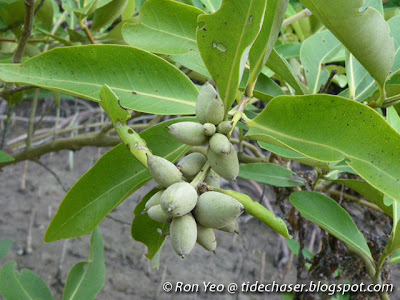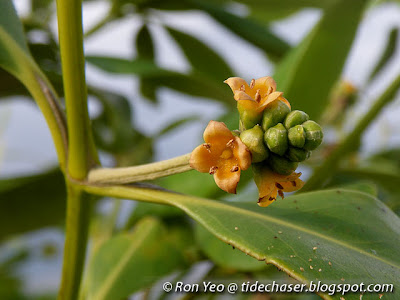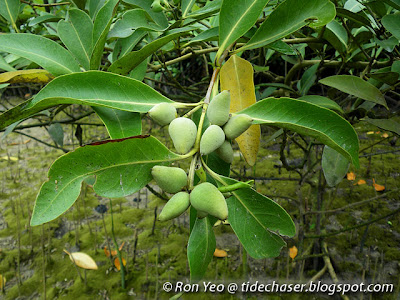The Api-api Jambu (Avicennia marina) is a nationally critically endangered mangrove tree from the family Acanthaceae. Interestingly, despite it being so rare in Singapore, it is possibly the most abundant and widespread Avicennia species in the world. "Api-api" means "fire-fire" or "firefly" in Malay, as some Avicennia species are noted to attract fireflies. Personally, I have seen fireflies congregating on Api-api Jambu in Sarawak.
On mainland Singapore, I have only seen a few tall trees (more than 5m) at Pandan Mangrove. It is more common on the islands though, with a good population on Pulau Tekong and Pulau Semakau, and a few trees on St John's Island. It is likely that this species may also be found on some of the more remote islands.
It is a pioneer species and usually occurs on sheltered shores.
The trunk is greenish/yellowish grey. Like other Avicennia species, it has pencil-like aerial roots (pneumatophores) to help the plant breathes air, which is scarce in the waterlogged soil. The roots spread over a wide area to help stabilise the tree on the unstable ground. These roots reportedly also trap sediments and hence reclaim land naturally.
Research indicated that roots of Avicennia marina also exclude salt from entering the plants, and salt filtration by the roots is by far its most important salt-rejecting mechanism, excluding some 80% of the salt carried towards the root surface by the transpiration stream.
It has simple, opposite leaves with pointed tips. They are green on the top side (with more yellow compared to A. alba), and yellow or whitish green on the underside. Salt glands on their undersides excrete up to 40% of the remaining quantity of salt which was not excluded at the roots.
Like the other Avicennia species, it has small yellow flowers, occurring in clusters. Young twigs have a squarish cross-section.
The fruits are in the shape of a fat inverted teardrops and are light green in colour. The plant exhibits cryptovivipary - the embryo grows to break through the seed coat but not the fruit wall before it splits open. Occasionally, vivipary is also observed, where the embryo grows and break through the seed coat and the fruit wall while still attached to the parent plant.
The wood from this tree are used to make paper in some countries, while the fruit is edible. Resins from the seeds are used to treat burns.
References
- Chong, K. Y., H. T. W. Tan & R. T. Corlett, 2009. A Checklist of the Total Vascular Plant Flora of Singapore: Native, Naturalised and Cultivated Species. Raffles Museum of Biodiversity Research, National University of Singapore. Singapore. 273 pp.
- Drennan, P., & N. W. Pammenter. 1982. Physiology of salt excretion in the mangrove Avicennia marina (Forsk.) Vierh. New Phytol. 91:597-606.
- Giesen, W., S. Wulffraat, M. Zieren & L. Scholten. 2006. Mangrove guidebook for Southeast Asia. RAP Publication 2006/07. FAO Regional Office for Asia and the Pacific & Wetlands International. Bangkok. 769 pp.
- Ng, P. K. L., and N. Sivasothi. 1999. A guide to the mangroves of Singapore 1 : the ecosystem & plant diversity. Singapore Science Centre. Singapore. 168 pp.
- Scholander, P. F., H. T. Hammel, E. Hemmingsen, & W. Garey. 1962. Salt balance in mangroves. Plant Physiology. 37:722-729.
- Waisel, Y., A. Eshel and M. Agami. 1986. Salt balance of leaves of the mangrove Avicennia marina. Physiologia Plantaruma. 67:67--72.

No comments:
Post a Comment